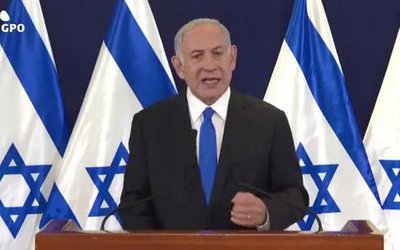No, Narendra Bhai, I am not thanking you for the billion dollar soft credit your have extended to Nepal without it having even been asked for. Given that Loktantra here quickly morphed into an all-party Loot-tantra and has now naturally progressed into a Don-tantra, easy money in the hands of a kleptocracy will not do any good to the people of Nepal. Indeed, given the likelihood of its misuse by the current dispensationbrought into existence by your own spook-led Raj via the 12-pont Delhi deal in November 2005, future generations of Nepalis might judge this to be intravenous feeding of Loot-tantra and may have to invoke the Doctrine of Odious Debts, something enshrined into international law by the US against Spain after taking over Cuba at the end of the 19th Century.
I also won’t thank you for “re-uniting” Jeet Bahadur Sarumagar with his family either. Apparently he had already been united with them two years earlier. You do need to be thanked profusely for taking a lost Nepali migrant child under your personal wings and giving him an opportunity he would never otherwise have. However, the manner in which all this was projected during your visit was too slick and kitsch a PR exercise. It not only detracted from the bigger merit of what you had done but also failed to address a far broader problem between our two countries: that of the mistreatment of Nepali labour as well as trafficked children and young girls, both within India and especially at the Nepal border when they return home.
Nepalis have similar misgivings about your puja at the Pashupatinath temple. Despite the fact thatNepal’s identity as ‘the world’s only Hindu kingdom’ was done away with by the regime change of 2006 aided and abetted by your Mughlani Raj and the EuroAmerican proselytizers, many Nepalis are happy that you at least demonstrated a reverse cultural assertion here at Pashupatinath as well as at Kashi Vishwanath (more on this below). Nepalis are glad that you, as a Hindu from India in your words, ‘bowed your head’ before Pashupatinath. However, what they feel very queasy about is your sacrilegiously occupying the religio-cultural seat of the King of Nepal during that puja. The rumblings heard here come from even strongly anti-Gyanendra folks who are being forced to ask: did we get rid of the King in Nepal only to have a Mughlani Badshah replace him as the ‘Hindu Samrat’?
You are a mesmerizing orator who convinced a billion people to vote for you. That you gave a brilliant speech at Nepal’s ‘back-paper’ parliament was to be expected; but I cannot thank you for that for a very simple reason. You unwittingly ended up showing how hollow in contrast our own current crop ofjana pratinidhis are: there they were applauding you for saying obvious things of history (Buddha’s place of birth) and political reality (Nepal’s sovereignty). They should instead have been hanging their heads in shame for failing to assert those self-evident truths by themselves all these years, for having to have you to remind them of that. I can only envy the Indian people for getting a leader like you, and feel sorry for myself that today we don’t have a Jang Bahadur to successfully deal with a Lord Dalhousie, a Chandra Shumshere with the likes of Lords Curzon, Minto, or Chlemsford, or a King Mahendra with a Nehru.
What you really need to be thanked for are four basic shifts your visit indicated. The first is the 1950 Treaty, a standard Leftist whipping boy, regarding which you said clearly that you are open to any suggestion Nepali leadership can come up with. It has now put the ball in Nepal’s court, where the debate has to move beyond cheap sloganeering to hard analysis and suggestions. Ever since it was signed, Nepalis have been fed the view that it is “unequal” and “demeaning”. Indeed, many of its provisions have become obsolete or observed in the breach only. It has also been interpreted unilaterally by India to impose an unprecedented peace time economic blockade of Nepal in March 1989.
Moving beyond the myths, the truth of the matter is that it was not signed in haste by the last Rana prime minister to save his regime: it was the result of Juddha Sumshere indicating, in 1938 at the first industrial exhibition in Kathmandu, of his desire to industrialize Nepal and the reaction of the British Raj to the danger to British industries “from cheap Gurkha labour”. After the Second World War, it was hastened by Mohan Sumshere’s need to assure Nepal’s membership in the newly founded United Nations. Nepalis and Indians have a difficult series of negotiations ahead and what you can do, Narendra Bhai, is not letting the goodwill you have generated from being locked in impasse prone bureaucratic positioning but keeping it engaged at the political level.
The second shift you indicated is in water resources where we have a sad half century history of stagnation. Much of it has come about because the Indian hydrocracy (which includes the South Block that enjoys veto power over all matters hydro and electric with the neighbours!) incomprehensively denies downstream benefits from dams in Nepal and refuses to share them equitably. Despite your hydrocracy sending a draft power development treaty that could have been drafted by the East India Company shortly after Sugauli, you indicated that you are both willing to pay a fair market price for electricity and accept that regulated water is of great use for you. How the colossal homework required by both sides to resolve the intricate “wicked problems” of multipurpose benefit sharingcan be done in the coming 45 days as per the joint statement issued at the end of your visit is something that has left Nepal’s academia and civic movements both flabbergasted and fearful.
The third subterranean shift has come about symbolically, with you avoiding the S-word, butthen not only doing puja in Pashupatinath on a Shravan Monday but lacing your speech liberally with Hindu scriptural metaphors. Your electoral victory in India was a tectonic cultural assertion that, as you mentioned at the Ganga aarti in Varanasi, had its origins not in the Nehruvian quasi-Anglo tradition but in that of Bal Gangadhar Tilak and Subhas Chandra Bose. You drove home that point by your actions, completely dismissing the Westernized INGO discourse around the S-word. (Ms Swaraj was equally devastating on the “big brother” appellation that drives much of the critique of Indian actions; and what she said in Hindi about the cultural connotation of “bade bhaiya” made a lot of sense. However, the metaphor was completely lost in translation, and instead provoked the backlash reaction that Nepal, older than the United States by six years, is definitely “elder” to India that is Bharat which is only six decades old.) The repercussions of these symbolic assertions will be felt for a long time and in many areas of culture and behavior, something agnostics and even outright atheists will be forced to come to terms with.
The fourth shift indicated by your (and earlier Ms Swaraj’s) overdue-by-decades visit, is the indication that the new Indian political class you have ushered in understands the disaster your predecessors’ Nepal policy has been. While you had to wish Nepal writes an impractical ‘federal republican’ constitution in which the Indian government hassurreptitiously invested so much over the decade since the regime change of 2006, you did gave a clear message that only a unity of the Tarai, hills and mountains would serve Nepal’s and India’s interest. You referred to the Tarai but did not mention Madhesh, which is a very recent, post-1990 construct by your spooks that has pampered only some of the Tarai ethnic groups but completely alienated the hill communities. This mistaken reading of Nepali social reality has allowed the emotional border (note: not physical or political) between China and Nepal to shift south to the Mahendra Highway.
Your attempt to correct these profound mistakes of the past, to let development rather than paranoid security define your government’s Nepal policy has been welcomed by the Nepali public at large. What Nepalis as well as the rest of South Asia are watching carefully is to see if your Modi Doctrine of improving neighborhood relations will really chart a new course or will your entrenched Babudom dilute and dismiss it as it did with the Gujral Doctrine as well as such initial positive moves by Prime Ministers Rajiv Gandhi and Chandrasekhar.

Dipak Gyawali
Gyawali is Pragya (Academician) of the Nepal Academy of Science and Technology (NAST) and former minister of water resources.
- Navigating An Uncharted, Unravelling World Order
- Jun 19, 2025
- Overcoming Indo-Pak Conflict The Dara Shikoh Way
- May 13, 2025
- Re-Thinking Democracy: Why South Asians Are worried
- Mar 17, 2025
- Nepal’s Governance Mired In Endemic Corruption
- Feb 20, 2025
- What Might The Age Of Trump Look Like?
- Jan 22, 2025















